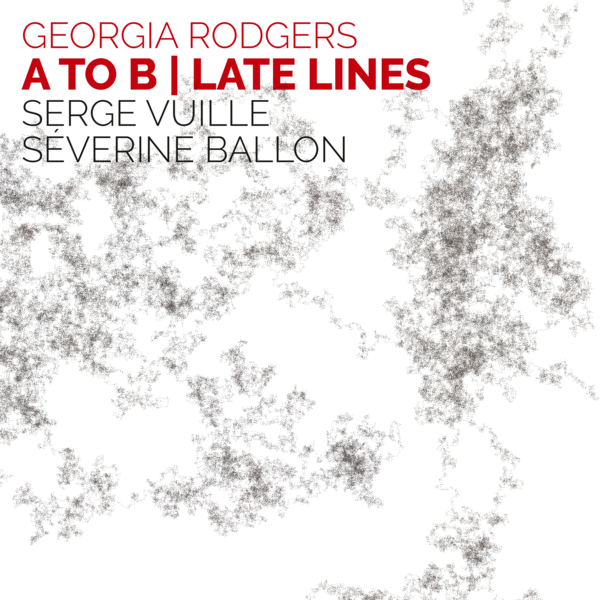
Georgia Rodgers
A to B | Late lines
Serge Vuille
Séverine Ballon
atd8
binaural download only

These two works by Georgia Rodgers place the activity of a soloist under a sonic microscope, using amplification to render tiny performance details larger-than-life. Computer processing leads to the instrumental sound being layered with itself, creating new spaces and trajectories, and confusing the distinction between ‘source’ and ‘environment’. Mastered for headphone listening in surround-sound binaural format.
Critical acclaim
Rodgers has discerning ears and keen antennae for musical architecture, and she never disappears down a rabbit-hole of forgetting that granular synthesis is only the means, not the ends. The simple massaging of skins and cymbals into life in A to B — kneading, scraping, tapping, tickling, slapping — is elevated to another level by the electronics, which colour in fleeting harmonic patterns and shift the natural percussive grain into the realm of acoustically impossible sustains and attacks.
Tracks
| 1 | A to B | 19:33 |
| 2 | Late lines | 16:30 |
| TT | 36:03 |
Liner notes
Composers writing for an instrument they play — or once played — seems to encourage them to access the physical side of music-making. Those embodied processes are dependent on and shaped by space and, at the same time, create space. Geographer Doreen Massey argues that space is not ‘a container for always-already constituted identities’ but must be recognised ‘as the product of inter-relations’. The productiveness of thinking about space differently, as called for by Massey, is explored through the compositions of Georgia Rodgers.
In A to B (2010) Rodgers returned to the percussion she had played at school, combining two snare drums and two cymbals with her more recently learned instruments, microphones and laptop. We sense a hands-on exploration of the percussion, with the material built up from the simplest of gestures: one quiet, regular finger-tap near the metal rim of the drum. The performer is instructed to explore the potential colours of the tone through varying first the dynamics and then where they play on the skin. The snare rattles into action. Further variations are dictated: the instruments are, as Rodgers puts it, ‘coaxed into vibration by means of tapping, scraping, rubbing, scratching, banging, thumping, slapping, flicking’. Eventually the performer moves onto the cymbals, starting with brushes which are then transferred to the snare drum. A pulse begins to be beaten out but then subsides.
The electronics, for their part, capture the output sound and submit it to granular synthesis. Rodgers describes the role of the electronics in these pieces as being like putting the percussion instruments under a sonic microscope. The potential for acoustic sounds thereby to be transformed is fully explored, the electronics acting like prostheses of the drums and cymbals that can ring longer and richer or move more quickly. Rodgers was keen to make the electronics dynamic and so uses live sampling to respond to what happens in performance. This is music that explores the process of composition and interpretation alongside the contingencies of live experience in the space of the concert hall or through the spatial simulation of these binaural recordings.
Robert Irwin’s conception of art as ‘conditional’ — determined by the world around us — is embodied in his series of ‘line’ paintings. The way light shifts over their elongated forms transforms the experience of them in time and space. It is an aesthetic that Rodgers found chimed with her approach to composition and that helped to develop her ideas about sound and listening. The result, in part, was embodied in Late lines, a piece initially worked on in 2012-13 in collaboration with cellist Séverine Ballon, transformed into an art installation for Glasgow Sound Thought in 2014, and revisited for this recording.
The object experienced — akin to Irwin’s canvases — in Late lines is the cello. The grain of the instrument’s voice is explored through varied bow strokes, its spectral sounds audible acoustically in concert but also amplified, sampled, delayed and filtered to build up layers that at times seem to cosset the listener, at others to threaten like an approaching tornado. In certain passages the electronics take over, the cellist no longer playing yet engulfed by the sounds she has created but that are now barely recognisable. Then the sound-mass reduces to reveal the fragile materiality of the acoustic instrument, its wooden body, its steel strings, the horse hair of its bow. Again, Rodgers’s music asks questions about ways in which liveness is heard: whether it exists in the bodies that play, in the bodies that are played, or in the relationship between those bodies and the spaces in which they co-exist.
Laura Tunbridge